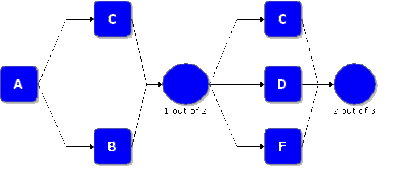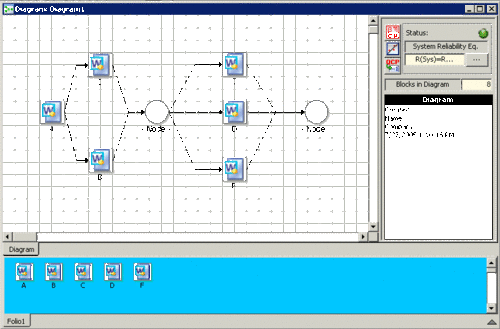Complex Failure Modes Example: Difference between revisions
(Created page with ''''Competing Failures with Complex Configuration Example''' Assume that a product has five failure modes: A, B, C, D and F. Furthermore, assume that failure of the product will …') |
No edit summary |
||
| Line 35: | Line 35: | ||
Using the Quick Calculation Pad (QCP), the estimated R( <math>100</math> hours <math>)</math> and the 90% two-sided confidence bounds are: | Using the Quick Calculation Pad (QCP), the estimated R( <math>100</math> hours <math>)</math> and the 90% two-sided confidence bounds are: | ||
::<math>\begin{matrix} | ::<math>\begin{matrix} | ||
Revision as of 17:59, 21 February 2012
Competing Failures with Complex Configuration Example
Assume that a product has five failure modes: A, B, C, D and F. Furthermore, assume that failure of the product will occur if mode A occurs, modes B and C occur simultaneously or if either modes C and D, C and F or D and F occur simultaneously. Times-to-failure for each mode is given in the next table.
The RBD that describes this configuration is shown next.
[math]\displaystyle{ }[/math]
One folio with multiple data sheets was created in Weibull++ for each of the data sets and each file was analyzed using the two-parameter Weibull distribution, MLE as the analysis method and Fisher Matrix as the confidence bounds method. A diagram is created by choosing Add Diagram from the Project menu. The failure modes can be inserted into the diagram by dragging them from the template. The nodes are inserted by clicking choosing Add Node from the Diagram menu.
[math]\displaystyle{ }[/math]
The number of required paths can be specified by double clicking the node and entering the appropriate number (1 in the first node and 2 in the second node).
[math]\displaystyle{ }[/math]
Using the Quick Calculation Pad (QCP), the estimated R( [math]\displaystyle{ 100 }[/math] hours [math]\displaystyle{ ) }[/math] and the 90% two-sided confidence bounds are:
- [math]\displaystyle{ \begin{matrix} {{{\hat{R}}}_{U}}(100)=0.991 \\ \hat{R}(100)=0.9905 \\ {{{\hat{R}}}_{L}}(100)=0.9080 \\ \end{matrix} }[/math]


